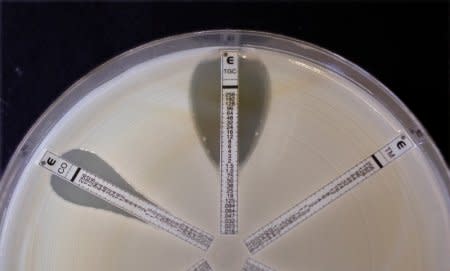Drug companies told to do more to tackle 'superbug' crisis

Thomson Reuters
By Ben Hirschler
LONDON (Reuters) - Drugmakers' response to the threat posed by "superbugs" remains patchy even after years of warnings, according to the first analysis of individual companies' efforts to tackle the antibiotic resistance crisis.
The rise of drug-resistant bacteria is a growing threat to modern medicine with the emergence of infections resistant to even last-resort antibiotics - a situation made worse in recent years by overuse of antibiotics and cutbacks in drug research.
New analysis by the non-profit Access to Medicine Foundation (AMI), published on Tuesday, found that GlaxoSmithKline and Johnson & Johnson were doing more than most among large research-based pharmaceutical companies to tackle the problem, while Mylan led the way among generic drugmakers and Entasis was top among biotechs.
But action taken by such companies is only the start of what could be done to address the problem, which former Goldman Sachs chief economist Jim O'Neill in 2014 estimated could cause 10 million deaths a year worldwide by 2050.
While a few more experimental antibiotics are now moving through development at both pharma and biotech companies, a lot more work still needs to be done to ensure appropriate use of medicines - both new ones and the thousands of tonnes of older pills churned out each year by generic companies.
"There's definitely more that all companies can do," said Jayasree Iyer, executive director of AMI, which published the analysis at the World Economic Forum annual meeting in Davos.
"We need to strengthen the research and development pipeline - and when new products reach the market we need to ensure that they are used in a conservative way, so that misuse and overuse is limited."
There are now 28 experimental antibiotics in late-stage development against critical pathogens but only two of these are supported by plans to ensure they can be both made accessible and used wisely if they reach the market.
The AMI said four companies - GSK, Shionogi, Pfizer and Novartis - had taken steps to separate sales representatives' bonuses from the volume of antibiotics sold, but much more needed to be done across the industry to counter overuse.
Another under-recognized problem is the pollution caused by mass production of antibiotics, due to lax oversight of wastewater run-off.
In India's Hyderabad region, for example, the presence of hundreds of drug factories and inadequate water treatment has left lakes and rivers laced with antibiotics, making the area a giant Petri dish for anti-microbial resistance.
The AMI urged multinational drugmakers to do more to ensure that their suppliers of bulk antibiotic ingredients were complying with rigorous wastewater standards.
(Reporting by Ben Hirschler; Editing by Susan Fenton)
See Also:

 Yahoo News
Yahoo News 
